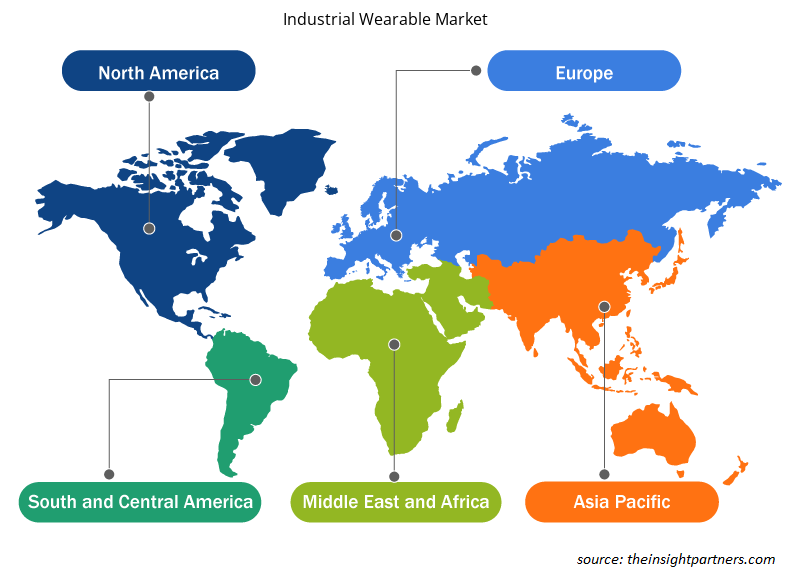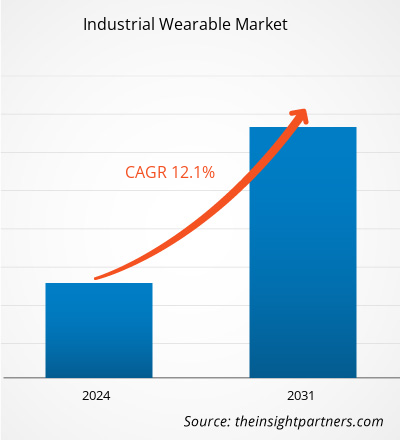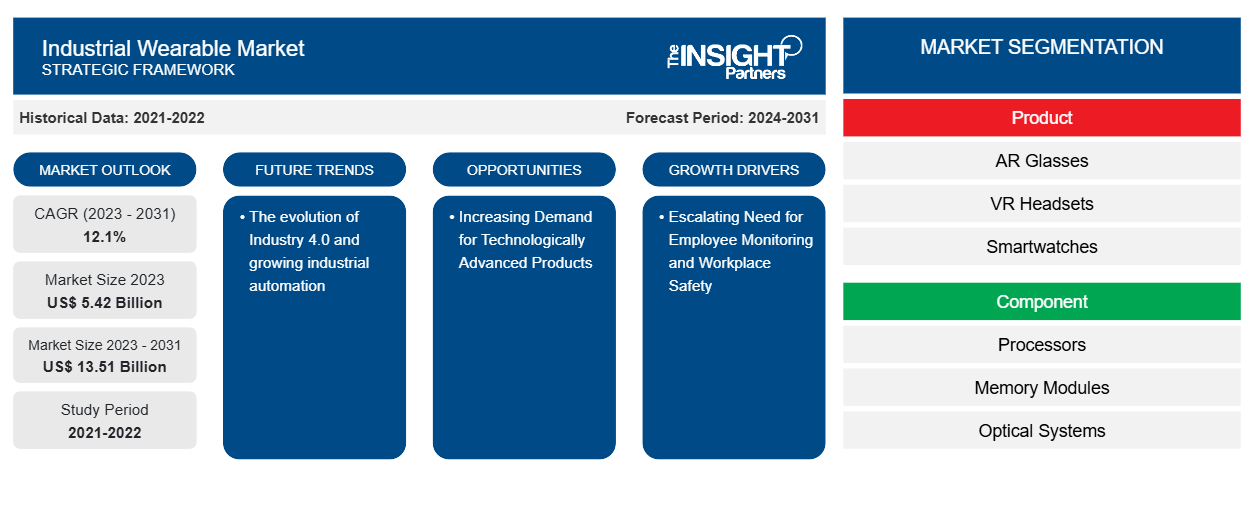Der Markt für industrielle Wearables soll von 5,42 Milliarden US-Dollar im Jahr 2023 auf 13,51 Milliarden US-Dollar im Jahr 2031 anwachsen. Der Markt soll zwischen 2023 und 2031 eine durchschnittliche jährliche Wachstumsrate (CAGR) von 12,1 % verzeichnen. Die Entwicklung von Industrie 4.0 und die zunehmende industrielle Automatisierung werden voraussichtlich weiterhin wichtige Trends auf dem Markt für industrielle Wearables bleiben.
Marktanalyse für industrielle Wearables
Der Markt für industrielle Wearables wächst rasant, da der Bedarf an Mitarbeiterüberwachung und Arbeitsplatzsicherheit steigt und die Zahl der Fertigungsanlagen weltweit zunimmt. Der Markt wächst stetig, angetrieben von der steigenden Nachfrage nach einer kollaborativen Arbeitsumgebung. Darüber hinaus bieten die steigende Nachfrage nach technologisch fortschrittlichen Produkten und die wachsende Nachfrage nach intelligenter Fertigung lukrative Möglichkeiten für Marktwachstum.
Marktübersicht für industrielle Wearables
Industrielle Wearables sind nützliche Geräte, die speziell zur Verbesserung der Sicherheit, Produktivität und Effizienz am Arbeitsplatz in Branchen wie Automobil, Luft- und Raumfahrt, Fertigung, Öl und Gas, Energie und Strom und anderen entwickelt wurden. Diese Geräte bestehen aus äußerst fortschrittlichen elektronischen Komponenten, um Aktionen zu verfolgen, Daten zu sammeln und personalisierte Erfahrungen basierend auf den Vorlieben und Bedürfnissen ihrer Benutzer anzubieten. Darüber hinaus sind sie darauf ausgelegt, arbeitsbedingte Gefahren zu beseitigen und es einem Mitarbeiter zu ermöglichen, die anstehende Aufgabe einfacher zu erledigen. Die weltweit zunehmende Zahl von Arbeitsunfällen erhöht die Nachfrage nach industriellen Wearables in verschiedenen Branchen und schafft so erhebliche Wachstumschancen für den Markt.
Passen Sie diesen Bericht Ihren Anforderungen an
Sie erhalten kostenlos individuelle Anpassungen an jedem Bericht, einschließlich Teilen dieses Berichts oder einer Analyse auf Länderebene, eines Excel-Datenpakets sowie tolle Angebote und Rabatte für Start-ups und Universitäten.
-
Holen Sie sich die wichtigsten Markttrends aus diesem Bericht.Dieses KOSTENLOSE Beispiel umfasst eine Datenanalyse von Markttrends bis hin zu Schätzungen und Prognosen.
Treiber und Chancen auf dem Markt für industrielle Wearables
Steigender Bedarf an Mitarbeiterüberwachung und Arbeitssicherheit treibt den Markt an
Viele Branchen verwenden an ihren Produktions- und Fertigungsstandorten robuste Maschinen, komplexe Systeme und leistungsstarke Geräte. Diese Maschinen und Geräte werden in zahlreichen Branchen wie Bergbau, Materialverarbeitung, Stahlherstellung und Bauwesen stark physisch genutzt, um die täglichen Aktivitäten effektiv auszuführen. Diese Branchen sind besonders anfällig für Schäden durch unvorhergesehene Fehler und Unfälle, was die Nachfrage nach effektiven Überwachungssystemen zur Verbesserung der Sicherheit am Arbeitsplatz erhöht und den Markt antreibt. Darüber hinaus erhöht das zunehmende Auftreten ungeplanter Fehler und Unfälle die Nachfrage nach industriellen Wearables zur Förderung der Sicherheit der Arbeitnehmer. Diese ungeplanten Unfälle am Arbeitsplatz können durch den Einsatz industrieller Wearables oder anderer Lösungen verhindert werden, die die Arbeitnehmer kontinuierlich überwachen können. Darüber hinaus wurde die Einführung dieser Artikel in dieser Branche durch die schnell steigenden arbeitsplatzbezogenen Sicherheitsanforderungen und -gesetze unterstützt.
Steigende Nachfrage nach technologisch fortschrittlichen Produkten – eine Chance auf dem Markt für industrielle Wearables
Die rasanten technologischen Fortschritte und die zunehmende Betonung von Innovation und Miniaturisierung eröffnen Chancen auf dem Markt. Unternehmen aus einer Vielzahl von Branchen versuchen, die IT weiter konsumorientiert zu gestalten, indem sie sich auf Wearables statt auf Smartphones und Tablets konzentrieren. Industrielle Wearables unterstützen Branchen dabei, kritische Gesundheitsindikatoren im Auge zu behalten und im Notfall schnell zu reagieren, was ihre Verbreitung in der Industrie steigert. Darüber hinaus liefern IoT-, KI- und Cloud-basierte industrielle Wearables auch Benachrichtigungen und Informationen sofort und intuitiv, sodass Warnleuchten oder Signaltöne überflüssig werden.
Segmentierungsanalyse des Marktberichts für industrielle tragbare Geräte
Wichtige Segmente, die zur Ableitung der Marktanalyse für industrielle Wearables beigetragen haben, sind die Produkt-, Komponenten- und Endbenutzerindustrie.
- Basierend auf dem Produkt ist der Markt für industrielle Wearables in AR-Brillen, VR-Headsets , Smartwatches und Smartbands, Patches und andere unterteilt. Das Segment der AR-Brillen hatte im Jahr 2023 einen größeren Marktanteil.
- Auf der Grundlage der Komponenten ist der Markt für industrielle Wearables in Prozessoren und Speichermodule, optische Systeme und Displays, elektromechanische Komponenten, Touchpads und Sensoren, Konnektivitätskomponenten, Kameramodule und andere unterteilt. Das Segment optische Systeme und Displays hatte im Jahr 2023 einen größeren Marktanteil.
- In Bezug auf die Endverbraucherbranche wird der Markt für industrielle Wearables in die Branchen Automobil, Luft- und Raumfahrt, Fertigung, Öl und Gas, Energie und Strom und andere unterteilt. Das Automobilsegment hatte im Jahr 2023 einen größeren Marktanteil.
Industrielle tragbare Marktanteilsanalyse nach Geografie
Der geografische Umfang des Marktberichts für industrielle Wearables ist hauptsächlich in fünf Regionen unterteilt: Nordamerika, Asien-Pazifik, Europa, Naher Osten und Afrika sowie Südamerika/Süd- und Mittelamerika.
In Bezug auf den Umsatz hatte der nordamerikanische Markt den größten Marktanteil im Bereich industrieller Wearables, was auf die Präsenz führender Akteure wie Vuzix Corporation, Blackline Safety Corp. und Kenzen, Inc. zurückzuführen ist. Diese Akteure entwickeln technologisch fortschrittliche Wearables, um den Arbeitern mehr Sicherheit zu bieten. Die Akteure konzentrieren sich auf die Entwicklung einer Vielzahl von Wearables, insbesondere AR-Brillen und VR-Headsets, um die Anforderungen verschiedener Endverbraucherbranchen zu erfüllen. Der nordamerikanische Markt wird im Prognosezeitraum voraussichtlich wachsen, da die Industrie zunehmend vernetzte und digitale Technologien einsetzt, um die betriebliche Produktivität zu verbessern. Darüber hinaus beflügelt die steigende Nachfrage nach AR-Brillen in der Automobilindustrie zur Automatisierung der Einrichtung, Konfiguration, Kalibrierung und Qualitätsprüfung von Automodellen den nordamerikanischen Markt.
Regionale Einblicke in den Markt für industrielle Wearables
Die regionalen Trends und Faktoren, die den Markt für industrielle Wearables während des Prognosezeitraums beeinflussen, wurden von den Analysten von Insight Partners ausführlich erläutert. In diesem Abschnitt werden auch die Marktsegmente und die Geografie für industrielle Wearables in Nordamerika, Europa, im asiatisch-pazifischen Raum, im Nahen Osten und Afrika sowie in Süd- und Mittelamerika erörtert.

- Erhalten Sie regionale Daten zum Markt für industrielle Wearables
Umfang des Marktberichts zu industriellen tragbaren Geräten
| Berichtsattribut | Details |
|---|---|
| Marktgröße im Jahr 2023 | 5,42 Milliarden US-Dollar |
| Marktgröße bis 2031 | 13,51 Milliarden US-Dollar |
| Globale CAGR (2023 - 2031) | 12,1 % |
| Historische Daten | 2021-2022 |
| Prognosezeitraum | 2024–2031 |
| Abgedeckte Segmente |
Nach Produkt
|
| Abgedeckte Regionen und Länder |
Nordamerika
|
| Marktführer und wichtige Unternehmensprofile |
|
Dichte der Marktteilnehmer für industrielle Wearables: Auswirkungen auf die Geschäftsdynamik verstehen
Der Markt für industrielle Wearables wächst rasant, angetrieben durch die steigende Nachfrage der Endnutzer aufgrund von Faktoren wie sich entwickelnden Verbraucherpräferenzen, technologischen Fortschritten und einem größeren Bewusstsein für die Vorteile des Produkts. Mit steigender Nachfrage erweitern Unternehmen ihr Angebot, entwickeln Innovationen, um die Bedürfnisse der Verbraucher zu erfüllen, und nutzen neue Trends, was das Marktwachstum weiter ankurbelt.
Die Marktteilnehmerdichte bezieht sich auf die Verteilung der Firmen oder Unternehmen, die in einem bestimmten Markt oder einer bestimmten Branche tätig sind. Sie gibt an, wie viele Wettbewerber (Marktteilnehmer) in einem bestimmten Marktraum im Verhältnis zu seiner Größe oder seinem gesamten Marktwert präsent sind.
Die wichtigsten Unternehmen auf dem Markt für industrielle Wearables sind:
- Sicherheitsdatenblatt von Blackline Safety Corp.
- Kenzen, Inc
- Kinetisch
- MaKusafe
- Weitere Informationen.
- Reactec GmbH
Haftungsausschluss : Die oben aufgeführten Unternehmen sind nicht in einer bestimmten Reihenfolge aufgeführt.

- Überblick über die wichtigsten Akteure auf dem Markt für industrielle Wearables
Neuigkeiten und aktuelle Entwicklungen zum Markt für industrielle Wearables
Der Markt für industrielle Wearables wird durch die Erhebung qualitativer und quantitativer Daten nach Primär- und Sekundärforschung bewertet, die wichtige Unternehmensveröffentlichungen, Verbandsdaten und Datenbanken umfasst. Im Folgenden finden Sie eine Liste der Entwicklungen auf dem Markt für industrielle Wearables und Strategien:
- Im April 2024 erhielt die Vuzix Corporation weitere Bestellungen für Vuzix M400 Smart Glasses von einem Fortune 100-Händler, um in erster Linie die Lager- und Logistikanforderungen dieses Kunden zu unterstützen. Vuzix Smart Glasses werden mittlerweile an mehreren Standorten weltweit eingesetzt, darunter in den USA, Kanada, Mexiko und im gesamten EMEA-Raum, und dieser Kunde expandiert seit Anfang 2024 weiter an immer mehr seiner Unternehmensstandorte. (Quelle: Vuzix Corporation, Pressemitteilung, 2024)
Marktbericht zu industriellen Wearables – Abdeckung und Ergebnisse
Der Bericht „Marktgröße und Prognose für industrielle tragbare Geräte (2021–2031)“ bietet eine detaillierte Analyse des Marktes, die die folgenden Bereiche abdeckt:
- Marktgröße und Prognose auf globaler, regionaler und Länderebene für alle wichtigen Marktsegmente, die im Rahmen des Projekts abgedeckt sind
- Marktdynamik wie Treiber, Beschränkungen und wichtige Chancen
- Wichtige Zukunftstrends
- Detaillierte PEST/Porters Five Forces- und SWOT-Analyse
- Globale und regionale Marktanalyse mit wichtigen Markttrends, wichtigen Akteuren, Vorschriften und aktuellen Marktentwicklungen
- Branchenlandschaft und Wettbewerbsanalyse, einschließlich Marktkonzentration, Heatmap-Analyse, prominenten Akteuren und aktuellen Entwicklungen
- Detaillierte Firmenprofile
- Historische Analyse (2 Jahre), Basisjahr, Prognose (7 Jahre) mit CAGR
- PEST- und SWOT-Analyse
- Marktgröße Wert/Volumen – Global, Regional, Land
- Branchen- und Wettbewerbslandschaft
- Excel-Datensatz
Aktuelle Berichte
Erfahrungsberichte
Grund zum Kauf
- Fundierte Entscheidungsfindung
- Marktdynamik verstehen
- Wettbewerbsanalyse
- Kundeneinblicke
- Marktprognosen
- Risikominimierung
- Strategische Planung
- Investitionsbegründung
- Identifizierung neuer Märkte
- Verbesserung von Marketingstrategien
- Steigerung der Betriebseffizienz
- Anpassung an regulatorische Trends























 Kostenlose Probe anfordern für - Markt für industrielle Wearables
Kostenlose Probe anfordern für - Markt für industrielle Wearables